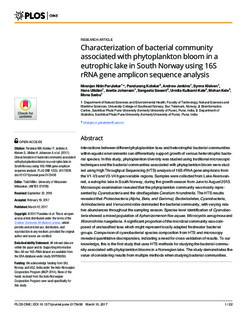| dc.contributor.author | Parulekar, Niranjan Nitin | |
| dc.contributor.author | Kolekar, Pandurang | |
| dc.contributor.author | Jenkins, Andrew | |
| dc.contributor.author | Kleiven, Synne | |
| dc.contributor.author | Utkilen, Hans Christian | |
| dc.contributor.author | Johansen, Anette | |
| dc.contributor.author | Sawant, Sangeeta | |
| dc.contributor.author | Kulkarni-Kale, Urmila | |
| dc.contributor.author | Kale, Mohan | |
| dc.contributor.author | Sæbø, Mona | |
| dc.date.accessioned | 2018-06-05T08:44:32Z | |
| dc.date.available | 2018-06-05T08:44:32Z | |
| dc.date.created | 2017-12-30T16:38:44Z | |
| dc.date.issued | 2017 | |
| dc.identifier.citation | PLoS ONE. 2017, 12 (3), 1-22. | nb_NO |
| dc.identifier.issn | 1932-6203 | |
| dc.identifier.uri | http://hdl.handle.net/11250/2500272 | |
| dc.description.abstract | Interactions between different phytoplankton taxa and heterotrophic bacterial communities within aquatic environments can differentially support growth of various heterotrophic bacterial species. In this study, phytoplankton diversity was studied using traditional microscopic techniques and the bacterial communities associated with phytoplankton bloom were studied using High Throughput Sequencing (HTS) analysis of 16S rRNA gene amplicons from the V1-V3 and V3-V4 hypervariable regions. Samples were collected from Lake Akersvannet, a eutrophic lake in South Norway, during the growth season from June to August 2013. Microscopic examination revealed that the phytoplankton community was mostly represented by Cyanobacteria and the dinoflagellate Ceratium hirundinella. The HTS results revealed that Proteobacteria (Alpha, Beta, and Gamma), Bacteriodetes, Cyanobacteria, Actinobacteria and Verrucomicrobia dominated the bacterial community, with varying relative abundances throughout the sampling season. Species level identification of Cyanobacteria showed a mixed population of Aphanizomenon flos-aquae, Microcystis aeruginosa and Woronichinia naegeliana. A significant proportion of the microbial community was composed of unclassified taxa which might represent locally adapted freshwater bacterial groups. comparison of cyanobacterial species composition from HTS and microscopy revealed quantitative discrepancies, indicating a need for cross validation of results. To our knowledge, this is the first study that uses HTS methods for studying the bacterial community associated with phytoplankton blooms in a Norwegian lake. The study demonstrates the value of considering results from multiple methods when studying bacterial communities. | nb_NO |
| dc.language.iso | eng | nb_NO |
| dc.rights | Navngivelse 4.0 Internasjonal | * |
| dc.rights.uri | http://creativecommons.org/licenses/by/4.0/deed.no | * |
| dc.title | Characterization of bacterial community associated with phytoplankton bloom in a eutrophic lake in South Norway using 16S rRNA gene amplicon sequence analysis | nb_NO |
| dc.type | Journal article | nb_NO |
| dc.type | Peer reviewed | nb_NO |
| dc.description.version | publishedVersion | nb_NO |
| dc.rights.holder | 2017, Parulekar et al. | nb_NO |
| dc.source.pagenumber | 1-22 | nb_NO |
| dc.source.volume | 12 | nb_NO |
| dc.source.journal | PLoS ONE | nb_NO |
| dc.source.issue | 3 | nb_NO |
| dc.identifier.doi | 10.1371/journal.pone.0173408 | |
| dc.identifier.cristin | 1533050 | |
| cristin.unitcode | 222,58,1,0 | |
| cristin.unitname | Institutt for natur, helse og miljø | |
| cristin.ispublished | true | |
| cristin.fulltext | original | |
| cristin.qualitycode | 1 | |

